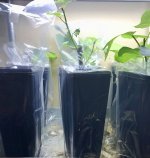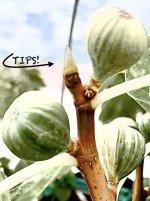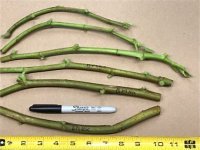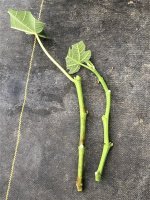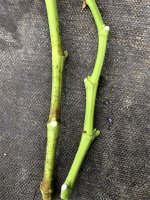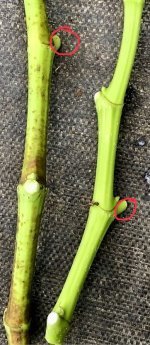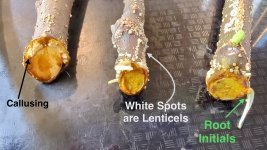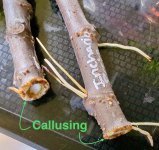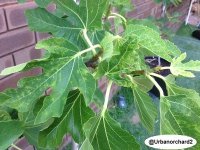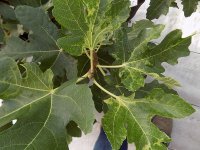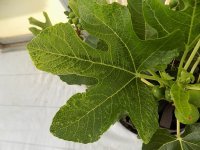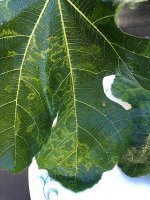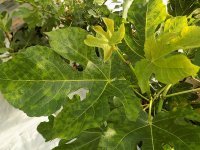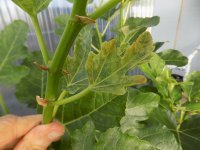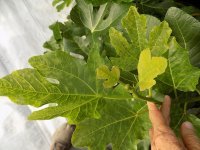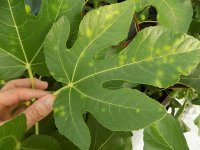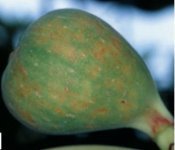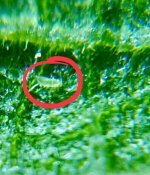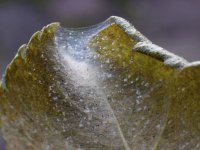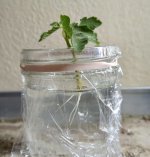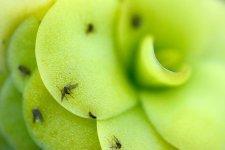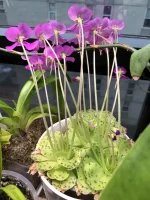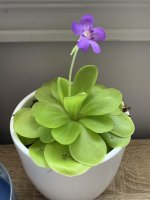ROOTING MIXES IN DETAIL
Having a good balance between aeration and moisture is important for rooting success. Air pockets keep roots healthy and moisture stimulates rooting.
Often growers propagate in a heavy mix or a fine mix that retains a lot of water. This can lack sufficient oxygen though which inhibits rooting. Water loss can also be slower during winter or in humid climates, which can prolong a reduced oxygen environment, leading to suffocation and anaerobic microbes taking over.
Using a substrate with a higher amount of perlite or other aerating materials really helps to prevent cutting death and keeps roots healthy. It’s also easier to work with as you don’t have to worry as much about having precise & measured watering.
Standard Mixes
A good starting ratio is 50/50 of peat to aerating materials or 60/40 coco coir to aerating materials, and should work in most environments. (Coco coir holds less water than peat, so a lower ratio of aerating materials can be used with it for a standard mix. Premade coco coir & perlite mixes are often in the 70/30 ratio, but can vary.)
Gritty Mixes
However, that ratio can change as much as up to about 10-20% peat or coco coir to 80-90% aerating 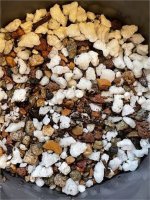 materials to make a very gritty & aerating mix. It is recommended to keep perlite to about 40% or less in such a mix and to use other aerating components that can retain some water. This is so the mix does not dry out too quickly as cuttings require consistent moisture to initiate rooting. I personally would keep perlite down to 15% or less.
materials to make a very gritty & aerating mix. It is recommended to keep perlite to about 40% or less in such a mix and to use other aerating components that can retain some water. This is so the mix does not dry out too quickly as cuttings require consistent moisture to initiate rooting. I personally would keep perlite down to 15% or less.
Why use a gritty mix to root? A gritty mix can be fantastic for very humid environments, if you like to water frequently, even every day, or if you have a cutting that you are worried will rot.
Picture Credit: PacNorWeck
One of the main detractors from using a very high ratio gritty mix is that the particles do not clump or hold together on their own. So, one needs to be very careful at up-potting that there is a significant amount of roots to hold everything together when the plant is removed from the pot. Even then, particles will fall out from the root area. This is problematic if the roots are too tender because they can be torn off the cutting. So, it is typically recommended to be very rootbound before the first up-pot using these.
*Note that gritty mixes require more frequent watering, and so if using, check your mix after 2 weeks (or sooner if extremely gritty) instead of the initial 4 weeks when bagged.
Particle Size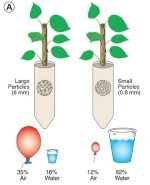
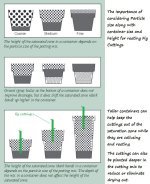
The other aspect that needs to be considered is particle size. For regular potting mix, I prefer really coarse materials so that they last a longer time. However, It can be challenging to use really large sized particles in rooting mix because the pots are usually smaller. I still err towards the larger size when possible as they usually work with my choice of materials in 4x9 treepots.
Picture Credit: AscPete
The finer the material used, the smaller the air pockets, and more water is typically retained with these. Larger particles create larger air pockets and so less water is retained. Larger particles throughout the mix also lowers the saturated zone in a container. Finer particles raises it. This applies even to the moisture retaining component. Think of fine coco coir compared to coco coir chunks. One will retain more water than the other and one will allow for larger pockets of oxygen.
Medium particle size is probably the best to aim for when rooting cuttings. Small, fine particles are best suited to seed starting and are not for cuttings. Too large of particles may not hold enough water to stimulate rooting. Sometimes a combination of fine & coarser materials is necessary due to availability and can be used together to balance a mix out.
Custom Mixes
Moisture Retaining Materials:
Coco coir
Sphagnum peat moss
Aerating materials:
Pumice, my favorite over perlite!
Coarse Perlite
Coarse Vermiculite*
Calcined Clay*
Coarse Granular Zeolite*
Coarse Grain Diatomaceous Earth*, such as OptiSorb sifted
Coarse Sand suitable for gardening, such as washed all-purpose builders sand
Crushed Granite
Expanded Shale
Chunky Coco Coir**
LECA*, #
*Indicates also has some moisture absorption & nutrient retaining ability. However, this is limited & not significant enough to put them in the moisture retention category. Their properties remain highly aerating in general.
** This is one that starts off aerating with some absorption, but will break down over time becoming only moisture retaining. Watch your particle size in relation to your container size.
#These should be hydrated before using so that they do not take moisture out of your rooting mix. Watch the size in relation to your container size.
Ratios:
Standard ratios for rooting mixes are anywhere from 70/30 to 50/50, moisture retaining / aerating.
A good gritty mix ratio is 1:1:1, with 1 part moisture retaining, 1 part aerating no absorption, and 1 part aerating with aborption.
An even heavier gritty mix can be made going up to 20/80, moisture retaining / aerating. (Try to keep perlite at 40% or less for the aerating portion. I recommend 15% or less.)
It is super easy to create your own custom mix to suit your needs and ingredient availability. Just choose your ingredients and your desired ratio based on the properties you would like it to have, and get to mixing!
Incorporating a Premade Mix Into Gritty Mix
Sunshine Mix #4, ProMix HP or BX, or a premade coco coir & perlite mix can be used for a gritty mix. This can be about a 1:1, 1:2 or 1:3 ratio when using these, depending on how gritty you want it.
Example, 1 part Sunshine Mix #4 to 1-3 parts other aerating materials. Because these already have perlite, another moisture absorbing aerating choice may be better, such as vermiculite or calcined clay.
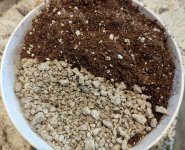
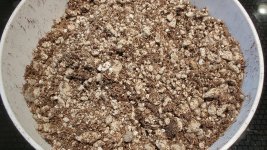 (From AscPete in his simplified rooting mix post using calcined clay.)
Potting Medium to Additional Aeration Ratios:
(From AscPete in his simplified rooting mix post using calcined clay.)
Potting Medium to Additional Aeration Ratios:
Sunshine Mix #4, 65-70% Peat start amt. Add in 1:1 ratio, 33-35% Peat end amt.
Sunshine Mix #4, 65-70% Peat start amt. Add in 1:2 ratio, 33-24% Peat end amt.
PRO-MIX BX, 75-85% Peat start amt. Add in 1:2 ratio, 25-28% Peat end amt.
PRO-MIX HP, 65-75% Peat start amt. Add in 1:1 ratio, 33-38% Peat end amt.
Coco Coir, 100% Coir. 1:2 ratio, 34% Coir
Peat Moss, 100% Peat. 1:2 ratio, 34% Peat
50/50 Peat & Perlite, 50% Peat. 1:2 ratio, 17% Peat
Organic Matter
I do not use organic material in my rooting mixes, such as compost or manures, as they encourage anaerobic bacterial growth in order to break down the organic matter, and can have insect eggs. This is not the environment we want for rooting. I save the organics for after rooting, once they are outside.
I do not recommend using wood based materials in rooting or potting mix as they are meant to break down and do not have a long life. I strongly feel that you do not want decomposing matter as the base around roots.
My Favorite Rooting Mixes
My favorite mix is 65/35 coco coir & perlite when buying premade. Otherwise, I like using pumice instead of perlite when making my own mix, and usually do about a 50/50 peat to pumice mix. Another favorite is 1 part peat, 1 part pumice, 1 part coarse vermiculite.


